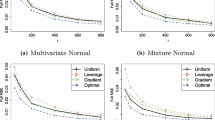Abstract
The successive sampling is a known technique that can be used in longitudinal surveys to estimate population parameters and measurements of difference or change of a study variable. The paper discusses the estimation of quantiles for the current occasion based on sampling in two successive occasions and using p-auxiliary variables obtained of the previous occasion. A multivariate ratio estimator from the matched portion is used to provide the optimum estimate of a quantile by weighting the estimates inversely to derived optimum weights. Its properties are studied under large–sample approximation and the expressions of the variances are established. The behavior of these asymptotic variances is analyzed on the basis of data from natural populations. A simulation study is also used to measure the precision of the proposed estimator.
Similar content being viewed by others
References
Adhvaryu D. (1978). Successive sampling using multi-auxiliary information. Sankhya 40: 167–173
Allen J., Singh H. P., Singh S. & Smarandache F. (2002). A general class of of population median using two auxiliary variables in double sampling. INTERSTAT. INTERSTAT — Statistics on the Internet. Blacksburg, USA: Virginia Polytechnic Institute and State University.
Arnab R., Okafor F.C. (1992). A note on double sampling over two occasions. Journal of Statistics 8: 9–18
Chambers R.L., Dunstan R. (1986). Estimating distribution functions from survey data. Biometrika 73: 597–604
Cochran W.G. (1977). Sampling Techniques, 3rd edn. New York, Wiley
Cramer H. (1946). Mathematical Methods of Statistics. Princeton, Princenton University Press
Eckler A.R.(1955). Rotation sampling. The Annals of Mathematical Statistics 26: 664–685
Eurostat, (2000). Low-wage employees in EU countries. In: Statistics in Focus: Population and Social Conditions. Theme 3-11/2000. Luxembourg: Office for Official Publications of the EC.
Gordon L. (1983). Successive sampling in finite populations. The Annals of Statistics 11: 702–706
Gross S.T.(1980). Median estimation in sample survey. In: Proceedings Survey and Research Method Section American Statistical Association 181–184
Jessen R.J. (1942). Statistical investigation of a sample survey for obtaining farm facts. Iowa Agricultural Experiment Statistical Research Bulletin 304
Koenker R., Hallock K.F.(2001). Quantile regression. Journal of Economics 15(4): 143–156
Kuk A., Mak T.K.(1989). Median estimation in the presence of auxiliary information. Journal of the Royal Statistical Society B 51: 261–269
Mak T.K., Kuk A.Y.C. (1993). A new method for estimating finite–population quantiles using auxiliary information. The Canadian Journal of Statistics 25: 29–38
Narain R.D.(1953). On the recurrence formula in sampling on successive occasions. Journal of the Indian Society of Agricultural Statistics 5: 96–99
Olkin I. (1958). Multivariate ratio estimation for finite population. Biometrika 45: 154–165
Patterson H.D.(1950). Sampling on successive occasions with partial replacement of units. Journal of the Royal Statistical Society B 12: 241–255
Rao J.N.K., Kovar J.G., Mantel H.J.(1990). On estimating distribution functions and quantiles from survey data using auxiliary information. Biometrika 77(2): 365–375
Royal R.M., Cumberland W.G.(1981). An empirical study of the ratio estimator and estimators of its variance. Journal of the American Statistical Association 76: 66–77
Rueda M., Arcos A., Artés E. (1998). Quantile interval estimation in finite population using a multivariate ratio estimator. Metrika 47: 203–213
Ruspini E. (1999). Longitudinal research and the analysis of social change. Quality and Quantity 33: 219–227
Sedransk J., Meyer J. (1978). Confidence intervals for the quantiles of a finite simple random and stratified simple random sampling. Journal of the Royal Statistical Society B 40(2): 239–252
Sedransk J. & Smith P.J.(1988). Inference for finite population quantiles. In P. R. Krishnaiah & C. R. Rao (eds.), Handbook of Statistics Vol. 6, Chap. 11, North-Holland. pp. 267–289
Singh S., Joarder A.H., Tracy D.S.(2001). Median estimation using double sampling. Australlian and New Zealand Jourlnal of Statistics 43: 33–46
Singh H. P., Singh H.P., Singh V.P.(1992). A generalized efficient class of estimators of population mean in two phase and successive sampling. International Journal of Management Systems 8(2): 173–183
Singh S., Srivastrava A.K.(1973). Use of auxiliary information in two stage sampling. Journal of Indian Society of Agricultural Statistic 25: 101–104
Singh S. (2003). Advanced Sampling Theory With Applications: How Michael “Selected” Amy. The Netherlands, Kluwer Academic Publisher, pp. 1–1247
Solga H. (2001). Longitudinal surveys and the study of occupational mobility: panel and retrospective design in comparison. Quality and Quantity 35: 291–309
Valliant R., Dorfman A.H., Royall R.M.(2000). Finite Population Sampling and Inference: A Prediction Approach Wiley Series in Probability and Statistics, Survey Methodology Section. New York, Wiley
Author information
Authors and Affiliations
Corresponding author
Rights and permissions
About this article
Cite this article
Rueda, M.D.M., Muñoz, J.F. & Arcos, A. Successive Sampling to Estimate Quantiles with P-Auxiliary Variables. Qual Quant 42, 427–443 (2008). https://doi.org/10.1007/s11135-006-9052-4
Accepted:
Published:
Issue Date:
DOI: https://doi.org/10.1007/s11135-006-9052-4




